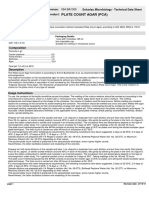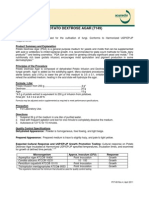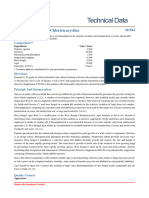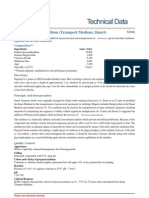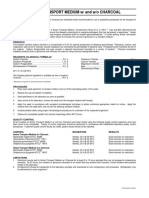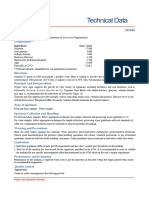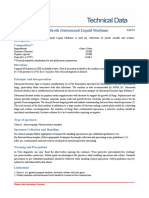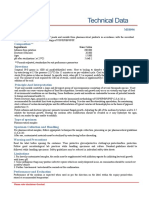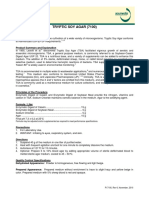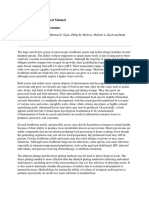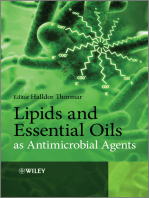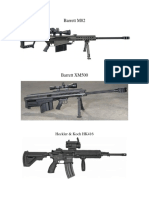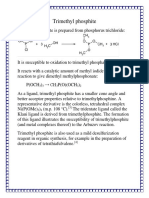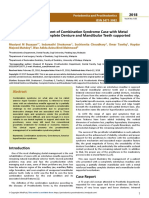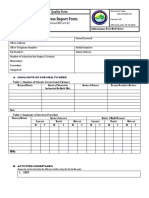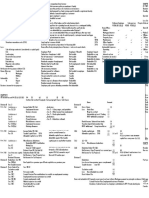Fluid Thioglycollate Medium (Thioglycollate Medium W/ Indicator and Dextrose)
Fluid Thioglycollate Medium (Thioglycollate Medium W/ Indicator and Dextrose)
Uploaded by
sinaCopyright:
Available Formats
Fluid Thioglycollate Medium (Thioglycollate Medium W/ Indicator and Dextrose)
Fluid Thioglycollate Medium (Thioglycollate Medium W/ Indicator and Dextrose)
Uploaded by
sinaOriginal Title
Copyright
Available Formats
Share this document
Did you find this document useful?
Is this content inappropriate?
Copyright:
Available Formats
Fluid Thioglycollate Medium (Thioglycollate Medium W/ Indicator and Dextrose)
Fluid Thioglycollate Medium (Thioglycollate Medium W/ Indicator and Dextrose)
Uploaded by
sinaCopyright:
Available Formats
FLUID THIOGLYCOLLATE MEDIUM
(THIOGLYCOLLATE MEDIUM w/ INDICATOR and DEXTROSE)
INTENDED USE
Remel Fluid Thioglycollate Medium (Thioglycollate Medium w/ Indicator and Dextrose) is a general-purpose, liquid medium recommended for
use in qualitative procedures for the cultivation of aerobes and anaerobes and for sterility testing.
SUMMARY AND EXPLANATION
Thioglycollate Medium was first described by Brewer in 1940.1 This medium contained a small amount of agar and a reducing substance to
initiate the growth of anaerobes.2 Fluid Thioglycollate Medium is recommended by the United States Pharmacopeia (USP) and the AOAC
International (AOAC).3,4 It is also recommended by the American Public Health Association (APHA) and Food and Drug Administration (FDA) in
the Bacteriological Analytical Manual Online.5,6
PRINCIPLE
Sodium thioglycollate is a reducing agent which maintains a low oxygen tension in anaerobic media. A small amount of agar is added to
impede diffusion of oxygen. Casein peptone and cystine supply nitrogenous and carbon compounds, while the sodium chloride maintains
osmotic equilibrium. Resazurin is added as an oxidation-reduction indicator which turns pink when increased oxidation occurs. Yeast extract
supplies B-complex vitamins and enhances the growth of microorganisms.
REAGENTS (CLASSICAL FORMULA)*
Casein Peptone ............................................................. 15.0 g L-Cystine........................................................................ 0.5 g
Yeast Extract ................................................................... 5.0 g Sodium Thioglycollate .................................................... 0.5 g
Dextrose .......................................................................... 5.0 g Resazurin ....................................................................... 1.0 mg
Sodium Chloride .............................................................. 2.5 g Agar .............................................................................. 0.75 g
Demineralized Water ................................................1000.0 ml
pH 7.1 ± 0.2 @ 25°C
*Adjusted as required to meet performance standards.
PRECAUTIONS
This product is For Laboratory Use only. It is not intended for use in the diagnosis of disease or other conditions.
PREPARATION OF DEHYDRATED CULTURE MEDIUM
1. Suspend 29.5 g of medium in 1000 ml of demineralized water.
2. Heat to boiling with agitation to completely dissolve.
3. Dispense into appropriate containers and sterilize by autoclaving at 121°C for 15 minutes.
4. Store prepared media at 15-30°C.
5. If more than 30% of the medium is pink, reheat medium only once in a boiling water or steam bath (100°C) to drive off absorbed oxygen
prior to use.
PROCEDURE
1. Consult current editions of appropriate references for the recommended procedure for sample preparation, inoculation, testing, and
interpretation.
QUALITY CONTROL
Each lot number of Fluid Thioglycollate Medium has been manufactured, packaged, and processed in accordance with current Good
Manufacturing Practice regulations. All lot numbers have been tested using the following quality control organisms and have been found to
be acceptable. Testing of control organisms should be performed in accordance with established laboratory quality control procedures.
CONTROL INCUBATION RESULTS
Clostridium sporogenes ATCC® 11437 Ambient, up to 3 days @ 30-35°C Growth
Kocuria rhizophila ATCC® 9341 Ambient, up to 3 days @ 30-35°C Growth
Pseudomonas aeruginosa ATCC® 9027 Ambient, up to 3 days @ 30-35°C Growth
Staphylococcus aureus ATCC® 6538 Ambient, up to 3 days @ 30-35°C Growth
LIMITATIONS
1. A slight turbidity (haziness) may be present due to the small amount of agar in the medium.
2. Do not boil more than once; frequent boiling results in development of toxic products.
3. Slight to moderate color variation of broth media does not affect performance.
4. Nonviable organisms may be seen when gram staining some culture media resulting from their presence in various media components.
BIBLIOGRAPHY
1. Brewer, J.H. 1940. JAMA. 115:598-600.
2. MacFaddin, J.F. 1985. Media for Isolation-Cultivation-Identification-Maintenance of Medical Bacteria. Vol. 1. Williams & Wilkins, Baltimore, MD.
3. The United States Pharmacopeia. 2009. 32nd ed. United States Pharmacopeial Convention, Rockville, MD.
4. Horwitz, W. 2002. Official Methods of Analysis of AOAC International. 17th ed., 1st rev. AOAC International, Washington, D.C.
5. Food and Drug Administration. 2000. Bacteriological Analytical Manual Online. AOAC International, Gaithersburg, MD. http://www.fda.gov/Food/
ScienceResearch LaboratoryMethods/BacteriologicalAnalyticalManualBAM/ucm055778.htm.
6. Downes, F.P. and K. Ito. 2001. Compendium of Methods for the Microbiological Examination of Foods. 4th ed. APHA, Washington, D.C.
Refer to the front of Remel Technical Manual of Microbiological Media for General Information regarding precautions, product storage and deterioration, sample
collection, storage and transportation, materials required, quality control, and limitations.
ATCC® is a registered trademark of American Type Culture Collection.
IFU 112640, Revised June 20, 2013 Printed in U.S.A.
12076 Santa Fe Drive, Lenexa, KS 66215, USA
General Information: (800) 255-6730 Website: www.remel.com Email: [email protected]
Local/International Phone: (913) 888-0939 International Fax: (913) 895-4128
You might also like
- Compromise Agreement SupportDocument3 pagesCompromise Agreement SupportMon81% (37)
- Industrial Water Quality and Quantity RequirementsDocument28 pagesIndustrial Water Quality and Quantity Requirementstulasi100% (7)
- MCQ's Blood BankDocument74 pagesMCQ's Blood BankAlireza Goodazri100% (2)
- Iso 11133:2014Document53 pagesIso 11133:2014Radi Tyo67% (6)
- RE FactorDocument3 pagesRE Factorsina100% (1)
- Potato Dextrose Agar (7149)Document2 pagesPotato Dextrose Agar (7149)Nelson MubaiNoch keine Bewertungen
- Letheen BrothDocument1 pageLetheen BrothEka Putri Juniarti IgirisaNoch keine Bewertungen
- IFU452672Document1 pageIFU452672davidbarraganrequena2bNoch keine Bewertungen
- Mrs Agar: Reference: Product: Scharlau Microbiology - Technical Data SheetDocument2 pagesMrs Agar: Reference: Product: Scharlau Microbiology - Technical Data SheetOlusegun OlasugbaNoch keine Bewertungen
- 064-Ba1005 enDocument2 pages064-Ba1005 enLaveria LaraswatiNoch keine Bewertungen
- Sabouraud Dextrose AgarDocument2 pagesSabouraud Dextrose AgarMohamad SyakirNoch keine Bewertungen
- TSB Presavation 15% GlycerolDocument1 pageTSB Presavation 15% GlycerolPhan Cảnh TrìnhNoch keine Bewertungen
- Brain Heart Infusion (Bhi) Agar: Intended UseDocument1 pageBrain Heart Infusion (Bhi) Agar: Intended Usemss67Noch keine Bewertungen
- Fluid Thio 2016Document2 pagesFluid Thio 2016WaleedNoch keine Bewertungen
- Neogen PDFDocument2 pagesNeogen PDFarwindarNoch keine Bewertungen
- Rose BengalDocument3 pagesRose BengalKhaza VinodNoch keine Bewertungen
- Chloran Rose Bengal Chloramphenicol Agar (DRBC Agar) : Intended UseDocument3 pagesChloran Rose Bengal Chloramphenicol Agar (DRBC Agar) : Intended Useபொ.தெய்வராஜன்Noch keine Bewertungen
- 7703 Pi PDFDocument3 pages7703 Pi PDFCinthia RebouçasNoch keine Bewertungen
- Milk Plate Count Agar (7703)Document3 pagesMilk Plate Count Agar (7703)Victor Manuel Gonzalez GeorgeNoch keine Bewertungen
- Littman Oxgall Agar W/ Streptomycin: Intended UseDocument1 pageLittman Oxgall Agar W/ Streptomycin: Intended UseJUAN PABLO VERGARA REYESNoch keine Bewertungen
- Stuart Transport MediaDocument2 pagesStuart Transport MediaRodolfo Jonathan DelevauxNoch keine Bewertungen
- Technical Paper CatfoodDocument12 pagesTechnical Paper Catfoodnajmuddin mohdramliNoch keine Bewertungen
- 7575 PiDocument2 pages7575 Pinor el ameneNoch keine Bewertungen
- Buffered Peptone Water (Iso) PH 7.0 (9262) : Revision: 6 Effective Date: 4/5/2017Document3 pagesBuffered Peptone Water (Iso) PH 7.0 (9262) : Revision: 6 Effective Date: 4/5/2017nurullahfatihNoch keine Bewertungen
- SabouraudDocument3 pagesSabouraudLesly ReyesNoch keine Bewertungen
- Lactobacillus Leichmannii Vitamina b12Document2 pagesLactobacillus Leichmannii Vitamina b12Santiago RochaNoch keine Bewertungen
- IFU1630Document1 pageIFU1630tecoluigiNoch keine Bewertungen
- Stuart Transport Medium (Transport Medium, Stuart) : Intended UseDocument3 pagesStuart Transport Medium (Transport Medium, Stuart) : Intended Useradiny audiaNoch keine Bewertungen
- 7101 PiDocument3 pages7101 PiRicky Mandala PutraNoch keine Bewertungen
- Testing Methods For ProteinDocument10 pagesTesting Methods For ProteinNikhil BharadwajNoch keine Bewertungen
- Tn1363en MKDocument3 pagesTn1363en MKFlorencia PieragostiniNoch keine Bewertungen
- FICHA TECNICA NCM0004A TRYPTIC SOY BROTH X 500 GR NEOGEN CmlabDocument2 pagesFICHA TECNICA NCM0004A TRYPTIC SOY BROTH X 500 GR NEOGEN CmlabSigrid BorjaNoch keine Bewertungen
- Clostridial Agar: Intended UseDocument3 pagesClostridial Agar: Intended Usesg.comNoch keine Bewertungen
- Amies Charcoal PDFDocument2 pagesAmies Charcoal PDFradiny audiaNoch keine Bewertungen
- BBL™ Mannitol Salt Agar - BDDocument2 pagesBBL™ Mannitol Salt Agar - BDyyewelsNoch keine Bewertungen
- Tryptic Soya Agar: Intended UseDocument2 pagesTryptic Soya Agar: Intended UseGopi NathNoch keine Bewertungen
- Sabouraud Dextrose Broth (Sabouraud Liquid Medium) : Intended UseDocument3 pagesSabouraud Dextrose Broth (Sabouraud Liquid Medium) : Intended UseCintya Arum SariNoch keine Bewertungen
- Bam 2001 Chapter 18Document11 pagesBam 2001 Chapter 18diasaripermataNoch keine Bewertungen
- Lactose Broth - For Detection of Coliforms and SalmonellaDocument4 pagesLactose Broth - For Detection of Coliforms and SalmonellatamtongNoch keine Bewertungen
- MH096Document3 pagesMH096Rocío CPérezNoch keine Bewertungen
- Litmus SM Broth: Intended Use: CompositionDocument3 pagesLitmus SM Broth: Intended Use: Compositionyayu sainaNoch keine Bewertungen
- HimediaDocument2 pagesHimediaWiwit MarianaNoch keine Bewertungen
- Tryptic Soy Agar (7100) : Formula May Be Adjusted And/or Supplemented As Required To Meet Performance SpecificationsDocument3 pagesTryptic Soy Agar (7100) : Formula May Be Adjusted And/or Supplemented As Required To Meet Performance SpecificationsMulyani Dwi YantiNoch keine Bewertungen
- IFU64620Document1 pageIFU64620Vivek VijayanNoch keine Bewertungen
- TDS MH443Document3 pagesTDS MH443florengrace.fg98Noch keine Bewertungen
- M-HPC Agar: Intended UseDocument1 pageM-HPC Agar: Intended UseAnna HerreraNoch keine Bewertungen
- CBE658 - Lab Report On Food PreservationDocument23 pagesCBE658 - Lab Report On Food PreservationGua HantuNoch keine Bewertungen
- Bams Chapter 18Document11 pagesBams Chapter 18winaNoch keine Bewertungen
- Cary - Blair MediumDocument2 pagesCary - Blair MediumnandhinisankaranNoch keine Bewertungen
- FO1081-01A MaxSignal® Oxytetracycline ELISA Test Kit Manual 07052014Document12 pagesFO1081-01A MaxSignal® Oxytetracycline ELISA Test Kit Manual 07052014phucongchiNoch keine Bewertungen
- Accelrated Testing Tortilla PDFDocument56 pagesAccelrated Testing Tortilla PDFMCF Gmail Master Craft FoodsNoch keine Bewertungen
- TSBDocument4 pagesTSBpfpkiNoch keine Bewertungen
- REAGEN Doxycycline ELISA Test Kit ManualDocument11 pagesREAGEN Doxycycline ELISA Test Kit ManualpetertrungNoch keine Bewertungen
- Laboratory Methods - Chap 18. BAM - Yeasts, Molds and MycotoxinsDocument10 pagesLaboratory Methods - Chap 18. BAM - Yeasts, Molds and MycotoxinsPhuong LeNoch keine Bewertungen
- Czapek Dox MediaDocument2 pagesCzapek Dox MediaPamela ChavesNoch keine Bewertungen
- Technical Data: Plate Count Agar (Standard Methods Agar)Document2 pagesTechnical Data: Plate Count Agar (Standard Methods Agar)பொ.தெய்வராஜன்Noch keine Bewertungen
- Sabouraud Dextrose Agar (European Pharmacopoeia) : CAT Nº: 1024Document0 pagesSabouraud Dextrose Agar (European Pharmacopoeia) : CAT Nº: 1024Fred GreenNoch keine Bewertungen
- Steility Test Validation Protocol by Direct Inoculation MethodDocument8 pagesSteility Test Validation Protocol by Direct Inoculation Methodutpal banikNoch keine Bewertungen
- Plate Count Agar (Standard Methods Agar) : Intended UseDocument3 pagesPlate Count Agar (Standard Methods Agar) : Intended UsenuraenirianNoch keine Bewertungen
- Pharmaceutical Product Registration Azithromycin Powder For Oral Suspension 200 mg/5 MLDocument379 pagesPharmaceutical Product Registration Azithromycin Powder For Oral Suspension 200 mg/5 MLNNoch keine Bewertungen
- 1064-01 MaxSignal® DON ELISA Test Kit ManualDocument10 pages1064-01 MaxSignal® DON ELISA Test Kit ManualsciroccoNoch keine Bewertungen
- Natrium Sodium Bicarbonate SDSDocument3 pagesNatrium Sodium Bicarbonate SDSAman BaigNoch keine Bewertungen
- Bake 5 - Micro - Quality High Risk Bakery Products, NZ 2007Document46 pagesBake 5 - Micro - Quality High Risk Bakery Products, NZ 2007Gaganpreet KaurNoch keine Bewertungen
- Lipids and Essential Oils as Antimicrobial AgentsFrom EverandLipids and Essential Oils as Antimicrobial AgentsHalldor ThormarNoch keine Bewertungen
- Piperidone AnalogsDocument10 pagesPiperidone AnalogssinaNoch keine Bewertungen
- Flash Powder: Aluminium and ChlorateDocument8 pagesFlash Powder: Aluminium and ChloratesinaNoch keine Bewertungen
- Gun PDFDocument2 pagesGun PDFsina100% (1)
- Submitted by Department of Chemistry, Imam Hossein University, Tehran, IRANDocument4 pagesSubmitted by Department of Chemistry, Imam Hossein University, Tehran, IRANsinaNoch keine Bewertungen
- Physical, Nuclear, and Chemical Properties of Plutonium: Institute For Energy and Environmental ResearchDocument5 pagesPhysical, Nuclear, and Chemical Properties of Plutonium: Institute For Energy and Environmental ResearchsinaNoch keine Bewertungen
- Plutonium ChemDocument16 pagesPlutonium ChemsinaNoch keine Bewertungen
- ArsenicDocument10 pagesArsenicsinaNoch keine Bewertungen
- Trimethyl PhosphiteDocument2 pagesTrimethyl PhosphitesinaNoch keine Bewertungen
- Methamphetamine PDFDocument3 pagesMethamphetamine PDFsinaNoch keine Bewertungen
- Silver Azide & Lead AzideDocument3 pagesSilver Azide & Lead AzidesinaNoch keine Bewertungen
- Flash PowderDocument6 pagesFlash PowdersinaNoch keine Bewertungen
- CIP Program Report 1999-2000Document484 pagesCIP Program Report 1999-2000cip-libraryNoch keine Bewertungen
- Basics of The Cognitive ApproachDocument2 pagesBasics of The Cognitive Approachajhh1234Noch keine Bewertungen
- Auveco HNI 490Document1 pageAuveco HNI 490BillNoch keine Bewertungen
- PHQ 9 PDFDocument2 pagesPHQ 9 PDFHumera Sarwar100% (1)
- Prosthodontic Management of Combination Syndrome Case With Metal Reinforced Maxillary Complete Denture and Mandibular Teeth Suppor PDFDocument5 pagesProsthodontic Management of Combination Syndrome Case With Metal Reinforced Maxillary Complete Denture and Mandibular Teeth Suppor PDFMonalisha DasNoch keine Bewertungen
- List of PhobiasDocument9 pagesList of PhobiasKean Dy Garcia100% (1)
- 01 Hazard-Identification PDFDocument72 pages01 Hazard-Identification PDFIndra HazamiNoch keine Bewertungen
- Public Health Career GuideDocument219 pagesPublic Health Career Guidejemil l. candiladaNoch keine Bewertungen
- Ok Sa Deped Accomplishment ReportDocument15 pagesOk Sa Deped Accomplishment ReportAnonymous YhZlC5AmNoch keine Bewertungen
- History Anesthesia 2003-2007Document9 pagesHistory Anesthesia 2003-2007John RaufNoch keine Bewertungen
- Taxation CheatsheetDocument2 pagesTaxation CheatsheetKem Hạt DẻNoch keine Bewertungen
- Committee For Medicinal Products For Veterinary Use (CVMP)Document6 pagesCommittee For Medicinal Products For Veterinary Use (CVMP)BBB.AAANoch keine Bewertungen
- Chapter 13: Microbe-Human Interactions: Infection, Disease, and EpidemiologyDocument11 pagesChapter 13: Microbe-Human Interactions: Infection, Disease, and EpidemiologyElloNoch keine Bewertungen
- Restaurant-Style Buffalo Chicken Wings Recipe - Allrecipes PDFDocument3 pagesRestaurant-Style Buffalo Chicken Wings Recipe - Allrecipes PDFlettyreirisNoch keine Bewertungen
- Group 2 ProposalDocument38 pagesGroup 2 ProposalMichael CalongcongNoch keine Bewertungen
- Assignment On Medical TourismDocument8 pagesAssignment On Medical TourismSurbhi SinghNoch keine Bewertungen
- Introduction To BiochemistryDocument32 pagesIntroduction To BiochemistryHazel LouNoch keine Bewertungen
- Merivaara Patient Bed Optima - Manual PDFDocument35 pagesMerivaara Patient Bed Optima - Manual PDFjosephNoch keine Bewertungen
- NCPDocument11 pagesNCPshmily_0810100% (1)
- Summary of Chakras N SURYA NAMASKARAMDocument7 pagesSummary of Chakras N SURYA NAMASKARAMsharmilanaiduuNoch keine Bewertungen
- RasGas Sustainability Report 2011 PDFDocument78 pagesRasGas Sustainability Report 2011 PDFjameskagomeNoch keine Bewertungen
- Tonsillectomy Slides 050427Document62 pagesTonsillectomy Slides 050427Aidiel Fikri100% (1)
- DRRR Week3-4Document6 pagesDRRR Week3-4Hannah BarcesaNoch keine Bewertungen
- DR Putut B - Slide-Diagnostic Challenges in Functional Dyspepsia - (PIN PAPDI 2019) - PDFDocument24 pagesDR Putut B - Slide-Diagnostic Challenges in Functional Dyspepsia - (PIN PAPDI 2019) - PDFMuhammad Ahmad bin makruf syammakuNoch keine Bewertungen
- NCP of CavDocument3 pagesNCP of CavHenry Roque TagalagNoch keine Bewertungen
- Position Paper 4Document9 pagesPosition Paper 4Charles Angel EspanolaNoch keine Bewertungen
- 0182-Cabin Crew CRM InstructorCRMIDocument3 pages0182-Cabin Crew CRM InstructorCRMImohammed bedourNoch keine Bewertungen









